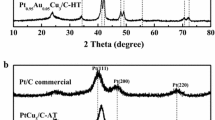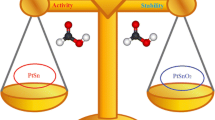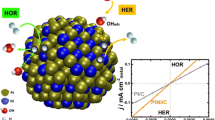Abstract
A deeper mechanistic understanding on CH3OH oxidation on Pt-Ru alloys with different Ru surface compositions is provided by DFT-based theoretical studies in this paper. The present results show that alloying and surface compositions of Ru can change CH3OH oxidation pathway and activity. The optimal surface composition of Ru is speculated to be ca. 50% since the higher Ru surface composition can lead to formation of carbonaceous species that can poison surface. Our present calculated Ru surface composition of ca. 50% exhibits excellent consistency with experimental studies. The origin of enhanced catalytic activity of Pt-Ru alloys is determined. The significantly decreased surface work functions after alloying suggest more electrons are transferred into adsorbates. The calculated lower electrode potentials after alloying imply that lower overpotentials are required for CH3OH oxidation. The excellent consistency with experimental study on decreased onset potentials after alloying further confirms accuracy of our present calculated results. It is hoped that a systematic understanding of the atomic- and molecular-level processes on CH3OH oxidation mechanisms on Pt-Ru alloys will result in the ultimate goal of the explanation of origin of enhanced electrocatalytic activity and design of improved Pt-based alloy electrocatalysts for DMFCs.
Graphical Abstract








Similar content being viewed by others
Data availability
Not applicable.
Code availability
Quantum ESPRESSO program package-http://www.quantum-espresso.org/; XCRYSDEN graphical package-http://www.xcrysden.org/.
References
Hamnett A (1997) Mechanism and electrocatalysis in the direct methanol fuel cell. Catal Today 38:445–457
Paulus UA, Endruschat U, Feldmeyer GJ, Schmidt TJ, Bonnemann H, Behm RJ (2000) New PtRu alloy colloids as precursors for fuel cell catalysts. J Catal 195:383–393
Gasteiger HA, Marković N, Ross PN, Cairns EJ (1994) Carbon monoxide electrooxidation on well-characterized platinum-ruthenium alloys. J Phys Chem 98:617–625
Watanabe M, Motoo S (1975) Electrocatalysis by ad-atoms: Part II. Enhancement of the oxidation of methanol on platinum by ruthenium ad-atoms. J Electroanal Chem Interfacial Electrochem 60:267–273
Gasteiger HA, Marković NM, Ross PN (1995) H2 and CO electrooxidation on well-characterized Pt, Ru, and Pt-Ru. 1. Rotating disk electrode studies of the pure gases including temperature effects. J Phys Chem 99:8290–8301
Sun YP, Xing L, Scott K (2010) Analysis of the kinetics of methanol oxidation in a porous Pt-Ru anode. J Power Sources 195:1–10
Lu QY, Yang B, Zhuang L, Lu JT (2005) Anodic activation of PtRu/C catalysts for methanol oxidation. J Phys Chem B 109:1715–1722
Xu JB, Hua KF, Sun GZ, Wang C, Lv XY, Wang YJ (2006) Electrooxidation of methanol on carbon nanotubes supported Pt-Fe alloy electrode. Electrochem Commun 8:982–986
Uchida H, Ozuka H, Watanabe M (2002) Electrochemical quartz crystal microbalance analysis of CO-tolerance at Pt-Fe alloy electrodes. Electrochim Acta 47:3629–3636
Hernández-Fernández P, Montiel M, Ocón P, Fierro JLG, Wang H, Abruña HD, Rojas S (2010) Effect of Co in the efficiency of the methanol electrooxidation reaction on carbon supported Pt. J Power Sources 195:7959–7967
Guo DJ, Cui SK (2009) Hollow PtCo nanospheres supported on multi-walled carbon nanotubes for methanol electrooxidation. J Colloid Interface Sci 340:53–57
Zhou XW, Zhang RH, Zhou ZY, Sun SG (2011) Preparation of PtNi hollow nanospheres for the electrocatalytic oxidation of methanol. J Power Sources 196:5844–5848
Jiang Q, Jiang LH, Hou HY, Qi J, Wang SL, Sun GQ (2010) Promoting effect of Ni in PtNi bimetallic electrocatalysts for the methanol oxidation reaction in alkaline media: experimental and density functional theory studies. J Phys Chem C 114:19714–19722
Jiang Q, Jiang LH, Wang SL, Qi J, Sun JQ (2010) A highly active PtNi/C electrocatalyst for methanol electro-oxidation in alkaline media. Catal Commun 12:67–70
Kim IT, Lee HK, Shim J (2008) Synthesis and characterization of Pt-Pd catalysts for methanol oxidation and oxygen reduction. J Nanosci Nanotechnol 8:5302–5305
Xu CW, Su YZ, Tan LL, Liu ZL, Zhang JH, Chen S, Jiang SP (2009) Electrodeposited PtCo and PtMn electrocatalysts for methanol and ethanol electrooxidation of direct alcohol fuel cells. Electrochim Acta 54:6322–6326
Neto AO, Dias RR, Tusi M, Linardi M, Spinaće EV (2007) Electro-oxidation of methanol and ethanol using PtRu/C, PtSn/C and PtSnRu/C electrocatalysts prepared by an alcohol-reduction process. J Power Sources 166:87–91
Yi QF, Zhang JJ, Chen AC, Liu XP, Xu GR, Zhou ZH (2008) Activity of a novel titanium-supported bimetallic PtSn/Ti electrode for electrocatalytic oxidation of formic acid and methanol. J Appl Electrochem 38:695–701
He WW, Wu XC, Liu JB, Zhang K, Chu WG, Feng LL, Hu XN, Zhou WY, Xie XX (2009) Pt-guided formation of Pt-Ag alloy nanoislands on Au nanorods and improved methanol electro-oxidation. J Phys Chem C 113:10505–10510
Zhao D, Wang YH, Yan B, Xu BQ (2009) Manipulation of Pt∧Ag nanostructures for advanced electrocatalyst. J Phys Chem C 113:1242–1250
Luo J, Njoki PN, Lin Y, Mott D, Wang LY, Zhong CJ (2006) Characterization of carbon-supported AuPt nanoparticles for electrocatalytic methanol oxidation reaction. Langmuir 22:2892–2898
Luo J, Maye MM, Kariuki NN, Wang LY, Njoki PN, Lin Y, Schadt M, Naslund HR, Zhong CJ (2005) Electrocatalytic oxidation of methanol: carbon-supported gold-platinum nanoparticle catalysts prepared by two-phase protocol. Catal Today 99:291–297
Xu CX, Wang RY, Chen MW, Zhang Y, Ding Y (2010) Dealloying to nanoporous Au/Pt alloys and their structure sensitive electrocatalytic properties. Phys Chem Chem Phys 12:239–246
Morante-Catacora TY, Ishikawa Y, Cabrera CR (2008) Sequential electrodeposition of Mo at Pt and PtRu methanol oxidation catalyst particles on HOPG surfaces. J Electroanal Chem 621:103–112
Buatier de Mongeot F, Scherer M, Gleich B, Kopatzki E, Behm RJ (1998) CO adsorption and oxidation on bimetallic Pt/Ru(0001) surfaces – a combined STM and TPD/TPR study. Surf Sci 411:249–262
Käsberger U, Jakob P (2003) Growth and thermal evolution of submonolayer Pt films on Ru(0001) studied by STM. Surf Sci 540:76–88
Jakob P, Schlapka A (2007) CO adsorption on epitaxially grown Pt layers on Ru(0001). Surf Sci 601:3556–3568
Schlapka A, Käsberger U, Menzel D, Jakob P (2002) Vibrational spectroscopy of CO used as a local probe to study the surface morphology of Pt on Ru(0001) in the submonolayer regime. Surf Sci 502:129–135
Schlapka A, Lischka M, Groß A, Käsberger U, Jakob P (2003) Surface strain versus substrate interaction in heteroepitaxial metal layers: Pt on Ru(0001). Phys Rev Lett 91:016101
Gazdzicki P, Thussing S, Jakob P (2011) Oxidation of methanol on oxygen covered Ptn/Ru(0001) layers. J Phys Chem C 115:23013–23022
Ou LH (2018) Theoretical insights into the effect of solvation and sublayer Ru on Pt-catalytic CH3OH oxidation mechanisms in the aqueous phase. J Phys Chem C 122:14554–14565
Franceschini EA, Bruno MM, Williams FJ, Viva FA, Corti HR (2013) High-activity mesoporous Pt/Ru catalysts for methanol oxidation. ACS Appl Mater Interfaces 5:10437–10444
Hoster H, Iwasita T, Baumgärtner H, Vielstich W (2001) Pt-Ru model catalysts for anodic methanol oxidation: influence of structure and composition on the reactivity. Phys Chem Chem Phys 3:337–346
Iwasita T, Nart FC, Vielstich W (1990) An FTIR study of the catalytic activity of a 85: 15 Pt: Ru alloy for methanol oxidation. Ber Bunsenges Phys Chem 94:1030–1034
Iwasita T, Hoster H, John-Anacker A, Lin WF, Vielstich W (2000) Methanol oxidation on PtRu electrodes. Influence of surface structure and Pt−Ru atom distribution. Langmuir. 16:522–529
Ross PN (1998) The science of electrocatalysis on bimetallic surfaces. In: Lipkowski J, Ross PN (eds) Electrocatalysis. Wiley-VCH, New York
Gasteiger HA, Marković N, Ross Jr PN, Cairns EJ (1993) Methanol electrooxidation on well-characterized Pt-Ru alloys. J Phys Chem 97:12020–12029
Gasteiger HA, Marković N, Ross Jr PN, Cairns EJ (1994) Temperature-dependent methanol electro-oxidation on well-characterized Pt-Ru alloys. J Electrochem Soc 141:1795–1803
Garrick TR, Diao WJ, Tengco JM, Stach EA, Senanayake SD, Chen DA, Monnier JR, Weidner JW (2016) The effect of the surface composition of Ru-Pt bimetallic catalysts for methanol oxidation. Electrochim Acta 195:106–111
Wang QM, Chen SG, Jiang J, Liu JX, Deng JH, Ping XY, Wei ZD (2020) Manipulating the surface composition of Pt-Ru bimetallic nanoparticles to control the methanol oxidation reaction pathway. Chem Commun 56:2419–2422
Gasteiger HA, Marković N, Ross Jr PN, Cairns EJ (1993) Electro-oxidation of small organic molecules on well-characterized Pt-Ru alloys. Electrochim Acta 39:1825–1832
Krausa M, Vielstich W (1994) Study of the electrocatalytic influence of Pt/Ru and Ru on the oxidation of residues of small organic molecules. J Electroanal Chem 379:307–314
Liu R, Iddir H, Fan Q, Hou G, Bo A, Ley KL, Smotkin ES, Sung YE, Kim H, Thomas S, Wieckowski A (2000) Potential-dependent infrared absorption spectroscopy of adsorbed CO and X-ray photoelectron spectroscopy of arc-melted single-phase Pt, PtRu, PtOs, PtRuOs, and Ru electrodes. J Phys Chem B 104:3518–3531
Waszczuk P, Wieckowski A, Zelenay P, Gottesfeld S, Coutanceau C, Leger JM, Lamy C (2001) Adsorption of CO poison on fuel cell nanoparticle electrodes from methanol solutions: a radioactive labeling study. J Electroanal Chem 511:55–64
Nagao R, Cantane DA, Lima FHB, Varela H (2013) Influence of anion adsorption on the parallel reaction pathways in the oscillatory electro-oxidation of methanol. J Phys Chem C 117:15098–15105
Bagotzky VS, Vassiliev YB, Khazova OA (1977) Generalized scheme of chemisorption, electrooxidation and electroreduction of simple organic compounds on platinum group metals. J Electroanal Interfacial Electrochem 81:229–238
Parsons R, Vandernoot T (1988) The oxidation of small organic molecules: a survey of recent fuel cell related research. J Electroanal Interfacial Electrochem 257:9–45
Greeley J, Mavrikakis M (2004) Competitive paths for methanol decomposition on Pt(111). J Am Chem Soc 126:3910–3919
Greeley J, Mavrikakis M (2002) A first-principles study of methanol decomposition on Pt(111). J Am Chem Soc 124:7193–7201
Cao D, Lu GQ, Wasileski SA, Neurock M (2005) Mechanisms of methanol decomposition on platinum: a combined experimental and ab initio approach. J Phys Chem B 109:11622–11633
Skúlason E, Tripković V, Björketun ME, Gudmundsdóttir S, Karlberg G, Rossmeisl J, Bligaard T, Jónsson H, Nørskov JK (2010) Modeling the electrochemical hydrogen oxidation and evolution reactions on the basis of density functional theory calculations. J Phys Chem C 114:18182–18197
Henderson MA (2002) Interaction of water with solid surfaces: fundamental aspects revisited. Surf Sci Rep 46:1–308
Ogasawara H, Brena B, Nordlund D, Nyberg M, Pelmenschikov A, Pettersson LGM, Nilsson A (2002) Structure and bonding of water on Pt(111). Phys Rev Lett 89:276102
Mattsson T, Paddison S (2003) Methanol at the water-platinum interface studied by ab initio molecular dynamics. Surf Sci 544:L697–L702
Okamoto Y, Sugino O, Mochizuki Y, Ikeshoji T, Morikawa Y (2003) Comparative study of dehydrogenation of methanol at Pt(111)/water and Pt(111)/vacuum interfaces. Chem Phys Lett 377:236–242
Methfessel M, Hennig D, Scheffler M (1992) Trends of the surface relaxations, surface energies, and work functions of the 4d transition metals. Phys Rev B 46:4816–4829
Skriver HL, Rosengaard NM (1992) Surface energy and work function of elemental metals. Phys Rev B 46:7157–7168
Lang ND, Kohn W (1971) Theory of metal surfaces: work function. Phys Rev B 3:1215–1222
Goodpaster JD, Bell AT, Head-Gordon M (2016) Identification of possible pathways for C-C bond formation during electrochemical reduction of CO2: new theoretical insights from an improved electrochemical model. J Phys Chem Lett 7:1471–1477
Gauthier JA, Ringe S, Dickens CF, Garza AJ, Bell AT, Head-Gordon M, Nørskov JK, Chan K (2019) Challenges in modelling electrochemical reaction energetics with polarizable continuum models. ACS Catal 9:920–931
Funding
This work was supported by the Key Program of Education Department of Hunan Province (Grant No. 19A337); Hunan Provincial Natural Science Foundation of China (Grant No. 2018JJ2273); Key Program of Hunan University of Arts and Science (Grant No. 19ZD06); National Natural Science Foundation of China (Grant No. 21303048).
Author information
Authors and Affiliations
Contributions
Lihui Ou contributed to the study conception and design. Data collection and analysis were performed by Lihui Ou. The first draft of the manuscript was written by Lihui Ou.
Corresponding author
Ethics declarations
Conflict of interest
The author declare no competing interests.
Additional information
Publisher’s note
Springer Nature remains neutral with regard to jurisdictional claims in published maps and institutional affiliations.
Supplementary Information
ESM 1
(DOC 1360 kb)
Rights and permissions
About this article
Cite this article
Ou, L. Theoretical insights into effect of surface composition of Pt-Ru bimetallic catalysts on CH3OH oxidation: mechanistic considerations. J Mol Model 28, 149 (2022). https://doi.org/10.1007/s00894-022-05150-7
Received:
Accepted:
Published:
DOI: https://doi.org/10.1007/s00894-022-05150-7




